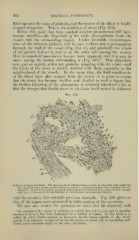Page 682 - My FlipBook
P. 682
692 — GENERAL PATHOLOGY.
filled up with the mass of globules, and the motion of the blood is finally
stopped altogether. This is the condition of stasis (Fig. 384),
Before this point has been reached another phenomenon will have
become manifest the cUapedesis of the tchite blood-globules from the
vessels into the surrounding tissues. Under favorable circumstances
some of the adherent globules will be seen to have sent a prolongation
through the wall of the vessel (Fig. 384, d), and gradually the whole
of the globule follows it, and is on the other side among the tissues.
Here its amoeboid movements become more apparent, and it is seen to
move among the tissues surrounding it (Fig. 385).' This diapedesis
now goes on rapidly, a few red globules mingling Avith the white, until
the Avhole of the tissue is thickly studded with them, especially in the
neighborhood of the vessels. In the mean time, the fluid con.'^tituents
of the blood have also escaped from the vessels to so great an extent
that the tissue has become swollen and clouded to such a degree that
the further following of the phenomena is seriously interfered with, so
that the changes that finally occur in the tissue itself cannot be followed
Fig. 386.
v^S^^;^^^-
\ %\^
Inflamcrl TTuman Onientiini. The plietioniena of inflammation are seen in the veins and capillaries,
the condition hcinst normal at the artery (r), where ft represents endothelium covering the tra-
bccula (a). In the vein (il) there am many white corpuscles along the wall : some of these are emi-
grating (e) ; /, desquamated endothelium ; ff, extravasated red corpuscles (Ziegler).
with the accuracy that scientific precision demands. Fig. 386 gives an
idea of the appearances presented in inflammation of the omentum.
We may now review the processes we have thus far observed, with
' On account of the var.iety of positions in whicli this cell is seen, and its peculiar
chanp;es of form, it has Iteen designated by a variety of names. In tiie blood it is
called the white blood-corpuscle or leucocyte; in the tissues outside of the blood-
vessels it is variously designated as the leucocyte, amceboid cell, or wandering cell.
These terms therefore api)ly to the san:e cell-forms.


